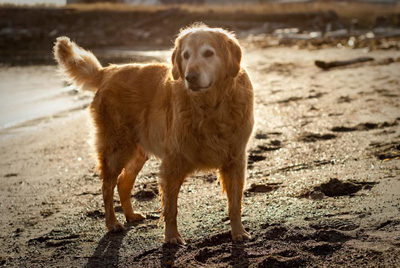Archive ∙ Back to Island Voices
August 2012

Chester. Photo credit: Tim Dustrude, 2011. Click photo to visit Tim’s web site at http://dustrude.com/
Our loved companions never live long enough and we inevitably lose them. A dignified, painless passing can be our final gift to our devoted four-leggeds. By taking control and making decisions that are best for you and your dog; you will be able to say good-bye gracefully.
Making the decision to help a friend die is by far the most difficult one you’ll ever make. It starts with deciding when to do it. This is different for every person and for every dog.
Let’s take Jenny’s dog Clyde. He had chronic renal failure—his kidneys were progressively deteriorating and couldn’t clear toxins from his bloodstream.
Initially, Clyde didn’t show any symptoms except excessive drinking and urination. Over time, the toxins in his blood increased; he started feeling nauseated and his appetite dropped.
Near the end, we anticipated that he’d stop drinking and start vomiting. In time, Clyde would slip into a coma before he finally died.
Jenny did not want her companion of 16 years to suffer this end. She decided that she must help him die before he reached the later stages of his disease. But, when would this be? If she waited too long, he would suffer needlessly; if she made the decision too soon, she would rob herself and him of precious time together.
No one could help Jenny answer this question. Only she could assess Clyde’s quality of life. She found that the decision had to come from her heart, not her head.
With a good understanding of what to expect with Clyde’s disease, Jenny decided that as soon as Clyde refused to eat and started vomiting, she would help him go. She enjoyed a full 6 months with her friend before she took him to her veterinary hospital for his final visit. He hadn’t drank water or eaten for two days. He was dehydrated, depressed and had started vomiting the day before.
In her heart, Jenny knew her companion was no longer enjoying life. She made the correct and kind decision to help him to die.
As the time for euthanasia approaches, many people arrange a special day with their companions. It may be a barbecued steak dinner; a last camping trip; a ride in the car; a walk along the beach; or just a little extra private time. Some caregivers take photographs or videos that serve as important reminders of their special four-legged companions.
Euthanasia is often performed at the veterinary hospital. The question many face is – do I stay with my friend during the euthanasia? Some people feel it helps if they are present. Others feel their anxiety might stress their friends unnecessarily. Understanding the procedure and knowing what to expect can help you make a decision that is best for both of you. The procedure is similar in all veterinary hospitals, with minor variations. I’ll tell you what we do.
We begin by giving a tranquilizer. While your companion is relaxing, you can spend some private time with him. Some people choose to leave once their friend is relaxed. Most stay.
For the actual euthanasia, an intravenous injection of a very strong anesthetic solution (pentobarbital) is given. The only discomfort your friend might feel is the prick of the needle—no different from taking a blood sample. Because we sedate them, they rarely notice this.
Within seconds of administration, the anesthetic stops the brain and heart function. He slips into a final “sleep”. We confirm that your friend’s heart has stopped and he has died.
Several things can happen during a euthanasia that can be quite disconcerting if you don’t expect them. Your friend’s bladder and bowels may release following death. Some have “phantom breaths” or muscle twitches, both quite normal. Finally, your friend’s eyes will not close.
You may want to spend a few minutes with your companion at this time to say goodbye. You may also choose to take a reminder of your friend home with you such as a lock of hair or a well worn collar.
Prior to the euthanasia, try to discuss options for body care with your veterinarian. You may decide on a home burial or you may ask your veterinarian to take care of your friend’s body. You can request a private cremation (your pet’s ashes will be returned to you) or a communal cremation with other pets.
As you can see, the euthanasia process is far more than giving an injection. When making decisions, consider what is best both for you and your friend. Feel comfortable with how your pet will spend his final moments.
Explaining Pet Death to Children
For many children, the first time they are exposed to death is when a family pet dies. If parents handle the situation wisely, their children will be better equipped to deal with grief in the future.
Begin by being honest and using the correct terms when explaining euthanasia and death. Don’t say that euthanasia is “putting the animal to sleep”. Parents also tell the baby-sitter to put the children to sleep at 9:00. It’s confusing.
Consider this example. Well-meaning parents told their son that their beloved dog had been put to sleep. In his mind, the child understood that the dog had gone and was never coming back. A few weeks later, when a doctor told the child that he was going to be put to sleep (so he could have minor surgery), he was understandably upset.
Some people try to avoid dealing with death by telling their children that the family pet ran away or was given to a new home. In their minds, these children wonder why their best friends would abandon them, or why their parents would give their best friend to someone else.
When euthanasia is planned, you should talk about the death before it actually occurs. Get the children involved. This could take the form of “We are going to help Casey to die because we don’t want him to suffer. We want to stop the pain he is feeling”.
Should a child be present when a pet is euthanized? In some cases, you can ask your child what he wants to do. This helps him feel he is in control of the situation. Other times, you may not want your child to be present but you may consider letting him see the body after the euthanasia. Viewing the body can offer closure and your child won’t have any doubts that his friend is really dead.
Showing your child that you too are grieving lets him know how to react. If you hide your sadness, your child may wonder if he should act the same way.
For some children, holding a memorial may be an appropriate way to say goodbye to a canine companion. There are many ways to remember a pet. Your dog’s ashes or even a lock of hair can be buried in a favourite place. Many families plant a tree or write a poem in honour of their companions.
Archive ∙ Back to Island Voices


Leave a Reply